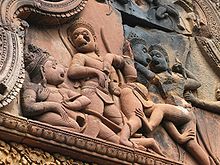
Khmer sculpture (Khmer: ចម្លាក់ខ្មែរ, Châmleăk Khmêr [cɑmˈlak kʰmae]) is the stone sculpture of the Khmer Empire, which ruled a territory based on modern Cambodia, but rather larger, from the 9th to the 13th century. The most celebrated examples are found in Angkor, which served as the seat of the empire.
Most of the sculpture is religious, reflecting the mixture of Hinduism and Buddhism followed in the empire. Large resources were devoted by the state to the erection of grand and highly decorated religious complexes, which often also serve to glorify the monarch.
There are several recognisable specific art styles of the Angkorian period:[1]
- Kulen style (c.825-875)
- Koh Ker style (941-944)
- Baphuon style (1010-1080)
- Angkor Wat style (1100-1175)
- Bayon style (late 12th to early 13th century)
- ^ "Khmer Art History". National Museum of Cambodia. Retrieved 13 March 2015.
